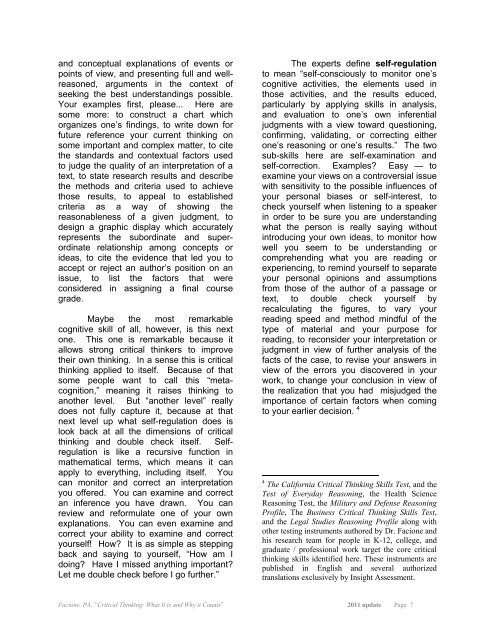Interpreting The Facts
Interpreting The Facts
Interpreting The Facts
You also want an ePaper? Increase the reach of your titles
YUMPU automatically turns print PDFs into web optimized ePapers that Google loves.
and conceptual explanations of events or<br />
points of view, and presenting full and wellreasoned,<br />
arguments in the context of<br />
seeking the best understandings possible.<br />
Your examples first, please... Here are<br />
some more: to construct a chart which<br />
organizes one’s findings, to write down for<br />
future reference your current thinking on<br />
some important and complex matter, to cite<br />
the standards and contextual factors used<br />
to judge the quality of an interpretation of a<br />
text, to state research results and describe<br />
the methods and criteria used to achieve<br />
those results, to appeal to established<br />
criteria as a way of showing the<br />
reasonableness of a given judgment, to<br />
design a graphic display which accurately<br />
represents the subordinate and superordinate<br />
relationship among concepts or<br />
ideas, to cite the evidence that led you to<br />
accept or reject an author’s position on an<br />
issue, to list the factors that were<br />
considered in assigning a final course<br />
grade.<br />
Maybe the most remarkable<br />
cognitive skill of all, however, is this next<br />
one. This one is remarkable because it<br />
allows strong critical thinkers to improve<br />
their own thinking. In a sense this is critical<br />
thinking applied to itself. Because of that<br />
some people want to call this “metacognition,”<br />
meaning it raises thinking to<br />
another level. But “another level” really<br />
does not fully capture it, because at that<br />
next level up what self-regulation does is<br />
look back at all the dimensions of critical<br />
thinking and double check itself. Selfregulation<br />
is like a recursive function in<br />
mathematical terms, which means it can<br />
apply to everything, including itself. You<br />
can monitor and correct an interpretation<br />
you offered. You can examine and correct<br />
an inference you have drawn. You can<br />
review and reformulate one of your own<br />
explanations. You can even examine and<br />
correct your ability to examine and correct<br />
yourself! How? It is as simple as stepping<br />
back and saying to yourself, “How am I<br />
doing? Have I missed anything important?<br />
Let me double check before I go further.”<br />
<strong>The</strong> experts define self-regulation<br />
to mean “self-consciously to monitor one’s<br />
cognitive activities, the elements used in<br />
those activities, and the results educed,<br />
particularly by applying skills in analysis,<br />
and evaluation to one’s own inferential<br />
judgments with a view toward questioning,<br />
confirming, validating, or correcting either<br />
one’s reasoning or one’s results.” <strong>The</strong> two<br />
sub-skills here are self-examination and<br />
self-correction. Examples? Easy — to<br />
examine your views on a controversial issue<br />
with sensitivity to the possible influences of<br />
your personal biases or self-interest, to<br />
check yourself when listening to a speaker<br />
in order to be sure you are understanding<br />
what the person is really saying without<br />
introducing your own ideas, to monitor how<br />
well you seem to be understanding or<br />
comprehending what you are reading or<br />
experiencing, to remind yourself to separate<br />
your personal opinions and assumptions<br />
from those of the author of a passage or<br />
text, to double check yourself by<br />
recalculating the figures, to vary your<br />
reading speed and method mindful of the<br />
type of material and your purpose for<br />
reading, to reconsider your interpretation or<br />
judgment in view of further analysis of the<br />
facts of the case, to revise your answers in<br />
view of the errors you discovered in your<br />
work, to change your conclusion in view of<br />
the realization that you had misjudged the<br />
importance of certain factors when coming<br />
to your earlier decision. 4<br />
4 <strong>The</strong> California Critical Thinking Skills Test, and the<br />
Test of Everyday Reasoning, the Health Science<br />
Reasoning Test, the Military and Defense Reasoning<br />
Profile, <strong>The</strong> Business Critical Thinking Skills Test,<br />
and the Legal Studies Reasoning Profile along with<br />
other testing instruments authored by Dr. Facione and<br />
his research team for people in K-12, college, and<br />
graduate / professional work target the core critical<br />
thinking skills identified here. <strong>The</strong>se instruments are<br />
published in English and several authorized<br />
translations exclusively by Insight Assessment.<br />
Facione, PA, “Critical Thinking: What It is and Why it Counts” 2011 update Page 7

















